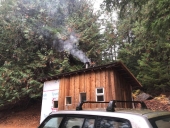


10 Podcast Review of the book Just Enough by Azby Brown
will be released to subscribers in:
soon!







 2
2





 1
1




For all your Montana Masonry Heater parts (also known as) Rocket Mass heater parts.
Visit me at
dragontechrmh.com Once you go brick you will never go back!




thomas rubino wrote:Hi Jacob;
When I had an 8" cast J tube core and a cast riser , I regularly had barrel top temps of 1100F But no higher. 1300 F sounds like a batchbox design rather than a J tube.
I replaced my cast core after the first season, because (like yours) the feed tube was too fragile. I was constantly trying to patch it.
I replaced it with an all heavy firebrick core . Now I can get +1000 F on the barrel top...only if I baby it with small wood. It regularly runs around 800 F.
My fireclay / perlite cast riser I have continued to use on my studio / greenhouse rmh. I am planning on replacing it next season with a five minute riser made from stove pipe and ceramic fiber blanket.
As Fox suggested ceramic fiber board/blanket is the newest best product's to build your rmh from. The downside is that it costs a whole lot more than clay and perlite.
I am currently building a J tube with ceramic boards and a riser with ceramic blanket. I have high expectations from these build materials, I expect the extra costs involved to be balanced out by the superior performance from them. It added over $300 to the build cost.
These products may not be available in your area.... If that is the case, then building your burn tunnel with insulated bricks is an excellent idea. If you have enough, then build your riser from insinuative bricks as well. Use the heavy firebrick to build your feed tube. Split heavy brick would be even better.
 1
1








 1
1




For all your Montana Masonry Heater parts (also known as) Rocket Mass heater parts.
Visit me at
dragontechrmh.com Once you go brick you will never go back!
 1
1




 .
.




God of procrastination https://www.youtube.com/watch?v=q1EoT9sedqY
 1
1




Satamax Antone wrote:Jackob, i think your porit bricks, are not insulating firebricks, but air entrained concrete, which cracks everywhere, under intense heat.

|
The harder I work, the luckier I get. -Sam Goldwyn tiny ad:
Rocket Mass Heater Resources Wiki
https://permies.com/w/rmh-resources
|






